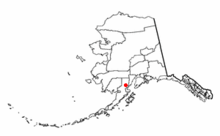Iliamna Lake
| Iliamna Lake | |
|---|---|
| Location | Lake and Peninsula Borough, Alaska |
| Coordinates | 59°32′12″N 155°01′28″W / 59.53667°N 155.02444°W[1] |
| Type | oligotrophic |
| Primary outflows | Kvichak River |
| Basin countries | United States |
| Max. length | 77 mi (124 km)[2] |
| Max. width | 22 mi (35 km)[2] |
| Surface area | 1,012.5 sq mi (2,622 km2)[2] |
| Average depth | 144 ft (44 m)[2] |
| Max. depth | 988 ft (301 m)[2] |
| Water volume | 27.7 cu mi (115 km3)[2] |
| Residence time | 7.8 years[2] |
| Surface elevation | 46 ft (14 m)[1] |
| Settlements | Iliamna, Newhalen, Kokhanok, Pedro Bay, Igiugig |
| References | [1][2] |
Iliamna Lake or Lake Iliamna is a lake in southwest Alaska, at the north end of the Alaska Peninsula, between Kvichak Bay and Cook Inlet, about 100 miles (160 km) west of Seldovia, Alaska.[1]
It is the largest lake in Alaska, eighth largest lake in the United States of America, and one of the largest in North America, covering about 2,600 km² (1,000 sq. miles). The lake is 77 miles (124 km) long and up to 22 miles (35 km) wide, with a maximum depth of 988 feet (301 m). Through the Kvichak River, its waters drain into Bristol Bay.[3]
Hydrology
Geology
Natural history

Lake Iliamna is a historically natural place, known for it's natural beauty and rich history.
History
Name
The lake is marked as 'Oz[ero] Bol[shoy] Ilyamna' (Big Ilyamna Lake) on the Russian Hydrographical Department's Chart 1455, published in 1852. On an earlier Russian map, from 1802, the lake was named 'Oz[ero] Shelekhovo' (Lake Shelekov). According to G.C. Martin, of the United States Geological Survey, Iliamna is said to be "the name of a mythical great blackfish supposed to inhabit this lake, which bites holes in the bidarkas of bad natives."[1]
The name Iliamna is derived from the Inland Dena'ina Athabascan name "Nila Vena" which means island's lake. [4]
Economy
Williamsport-Pile Bay Road Portage
Williamsport-Pile Bay Road is a utility-class road maintained by the State of Alaska to connect Pile Bay on the Northeast side of Lake Iliamna to Williamsport, a tiny settlement on Iliamna Bay of Cook Inlet, about 100 miles from Homer, Alaska on the other side of Cook Inlet. 15.5 miles long and a single lane wide with 4 bridges, Williamsport-Pile Bay Road is maintained as a gravel utility road for the purpose of hauling boats and freight, and is not intended for general purpose use. The road allows boats (at least those which can fit across the bridges) to portage from Cook Inlet to Bristol Bay without braving the open ocean to go all the way around the Alaska Peninsula. The road is also believed to significantly reduce fuel costs for the Lake Iliamna and Bristol Bay regions.
Lists
Populated Places
The villages of Iliamna, Newhalen, Kokhanok, Pedro Bay, Pope-Vannoy Landing and Igiugig lie on the shores of Iliamna Lake.
Flora and Fauna
This section's tone or style may not reflect the encyclopedic tone used on Wikipedia. (May 2008) |
Wildlife
Iliamna Lake is noted for its sport fishing. The three primary targets of anglers in the lake are trout, salmon, and grayling. August through September is prime time for catching fat rainbow trout, some of which can exceed 28 inches long. The Kvichak River Policy (the drainage of Lake Iliamna) is catch and release on trout (and all other native fish), so if you're looking for a meal then salmon is your best bet. Sockeye (Red) and Chinook (King) Salmon are consistently found in the lake and are open to harvest under Alaska Department of Fish and Game Regulations. Lake
Iliamna also has one of few populations of freshwater seals in the world.[5]
Monster
Local residents have a number of stories about the alleged Iliamna Lake Monster, an aquatic creature much like the rumored Loch Ness Monster.[6] Speculation exists that reported sightings may be an undocumented population of white sturgeon. If true, this would be the most northerly population known to exist, just a few hundred miles from the Arctic Circle. Jeremy Wade of Animal Planet's "River Monsters" is among those who speculate these sightings of a reputed "monster" is a White Sturgeon.
Images
See also
References
- ^ a b c d e U.S. Geological Survey Geographic Names Information System: Iliamna Lake
- ^ a b c d e f g h Mathisen, Ole A. (July 2002). "Trophic ranking of biota in Iliamna Lake, Alaska" (PDF). Verh. Internat. Verein. Limnol. 28. Stuttgart: 1060–1065. Retrieved 2008-11-13.
{{cite journal}}: Unknown parameter|coauthors=ignored (|author=suggested) (help) [dead link] - ^ "Profile of the People and Land of the United States". US Department of Interior, National Atlas of the United States.
- ^ Kari, James; Russell Kari, Priscilla (1982). Dena'ina E\nena: Tanaina Country. Alaska Native Language Center. p. 17.
- ^ "Resident Harbor Seals (Phoca vitulina) in Iliamna Lake, Alaska: Summer Diet and Partial Consumption of Adult Sockeye Salmon (Oncorhynchus nerka)", Aquatic Mammals, July 2008.
- ^ Snifka, Lynne (2004). "Monstrous mysteries". [[Alaska (magazine)|]]. v. 70 (8): 44(4). ISSN 0002-4562.
{{cite journal}}: Unknown parameter|month=ignored (help)
External links
- "Detailed topographic map" (JPEG). United States Topographic Maps 1:250,000. University of Texas. 1983. Retrieved 2008-05-22.
{{cite web}}: External link in|work=
